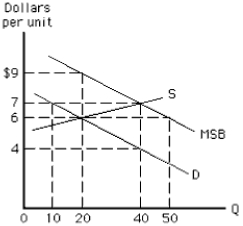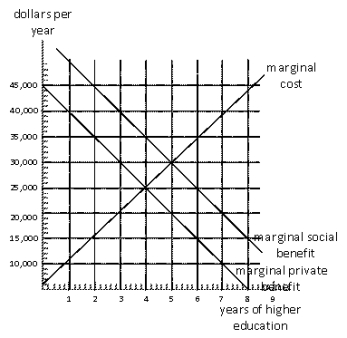A) $6 and 50 units, respectively
B) $12 and 50 units, respectively
C) $12 and 40 units, respectively
D) $6 and 40 units, respectively
E) not indicated
Correct Answer

verified
Correct Answer
verified
Multiple Choice
Exhibit 17-6  -Exhibit 17-6 illustrates the presence of
-Exhibit 17-6 illustrates the presence of
A) positive externalities
B) positive and negative externalities
C) negative externalities
D) the Coase theorem
E) a private market with a socially efficient equilibrium
Correct Answer

verified
Correct Answer
verified
Multiple Choice
Suppose research indicates that the effects of a one degree increase in Earth's average temperature would be much more devastating than previously believed. Therefore, the greater the marginal benefit of reducing greenhouse gases, other things constant,
A) the lower the optimal level of emissions
B) the higher the optimal level of emissions
C) the likelier that the level of emissions would have no effect
D) the lower the optimal level of cleaner air
E) None of the answers is correct
Correct Answer

verified
Correct Answer
verified
Multiple Choice
If producers cannot afford the fees for pollution rights,
A) they will pollute
B) they will buy pollution rights
C) they will sell pollution rights
D) they will have to find a cheaper way to deal with their pollution
E) they will not be able to use their pollution rights
Correct Answer

verified
Correct Answer
verified
Multiple Choice
When the free market produces less than the socially optimal quantity of a good,
A) negative externalities must be present
B) marginal social cost must exceed marginal private cost
C) marginal private benefit must exceed marginal social benefit
D) the government should tax production of the good
E) there has been a market failure
Correct Answer

verified
Correct Answer
verified
Multiple Choice
How much of U.S. garbage is disposed of in landfills?
A) 25 percent
B) 40 percent
C) 60 percent
D) 70 percent
E) 100 percent
Correct Answer

verified
Correct Answer
verified
Multiple Choice
To maximize social welfare in the presence of a negative externality, marginal __________ must equal marginal __________.
A) social cost; private cost
B) private cost; social cost
C) social cost; social benefit
D) private cost; social benefit
E) social cost; external cost
Correct Answer

verified
Correct Answer
verified
Multiple Choice
According to the Coase theorem, in order to solve a negative externality problem efficiently,
A) the property right must be assigned to the party with the least-cost alternative
B) the property right must be assigned to the victim of pollution
C) transaction costs must be high
D) transaction costs must be low
E) property rights must be determined by the courts
Correct Answer

verified
Correct Answer
verified
Multiple Choice
If a private market determines the quantity of smallpox vaccinations, which of the following is true?
A) The equilibrium quantity is too low for efficiency.
B) The equilibrium price and quantity are too high for efficiency.
C) The equilibrium price is efficient.
D) The equilibrium quantity is too high for efficiency.
E) The equilibrium price and quantity are efficient.
Correct Answer

verified
Correct Answer
verified
Multiple Choice
Renewable resources are those for which
A) additional units can be purchased in the market
B) additional units can be purchased in the market or provided by government
C) worn-out units can be repaired for further use
D) periodic use can be continued indefinitely
E) additional sources are constantly being discovered
Correct Answer

verified
Correct Answer
verified
Multiple Choice
The economic efficiency approach to emission control provides the polluting firm with
A) a license produce as much emissions as it wants
B) the option of choosing between focusing on profit or cost
C) a process for determining the optimum quantity of emissions
D) more flexibility in selecting the most cost effective method of control
E) a subsidy for producing additional emissions
Correct Answer

verified
Correct Answer
verified
Multiple Choice
If the benefits to society of students attending college exceed benefits to the students,
A) higher education should be strictly regulated
B) higher education should be taxed
C) higher education provides a positive externality
D) higher education is overproduced at the privately determined equilibrium
E) in time, no higher education will be produced
Correct Answer

verified
Correct Answer
verified
Multiple Choice
Robert Iwasaki lives next door to a toxic waste landfill. Katie Cooley lives five miles downstream from a steel plant that dumps waste into Mill Creek. Which person is more likely to press public officials for a cleaner environment?
A) Katie
B) Robert
C) neither
D) both equally
E) Economics cannot answer this question
Correct Answer

verified
Correct Answer
verified
Multiple Choice
Markets fail when externalities are present
A) because all of the costs and benefits of producing a good are reflected in the market price
B) because some of the costs and benefits of producing a good are not reflected in the market price
C) only if they are negative; positive externalities are not market failures
D) because profits are not maximized
E) if the positive externalities are less than the negative externalities
Correct Answer

verified
Correct Answer
verified
Multiple Choice
In the United States, what percentage of smog comes from manufacturing sites?
A) 5 percent
B) 15 percent
C) 25 percent
D) 40 percent
E) 80 percent
Correct Answer

verified
Correct Answer
verified
Multiple Choice
When consumption of a good creates positive externalities,
A) the private demand curve shifts rightward
B) the private demand curve shifts leftward
C) the private demand curve is below the marginal social benefit curve
D) the private demand curve is above the marginal social benefit curve
E) the equilibrium quantity determined by the free private market is too high
Correct Answer

verified
Correct Answer
verified
Multiple Choice
In order to increase society's well-being, education might be
A) taxed to discourage production
B) subsidized to encourage production
C) taxed to encourage production
D) subsidized to discourage production
E) provided without government intervention
Correct Answer

verified
Correct Answer
verified
Multiple Choice
The Clean Air Act of 1970
A) set up a depletion tax system
B) reduced air pollution standards
C) recognized air as a resource
D) established a system of transferable pollution rights
E) forbade producers to emit any pollutants into the air
Correct Answer

verified
Correct Answer
verified
Multiple Choice
Exhibit 17-8  -Exhibit 17-8 represents the consumer market for higher education. If people base their education decisions on the marginal social benefit of education, how many years of education will they get?
-Exhibit 17-8 represents the consumer market for higher education. If people base their education decisions on the marginal social benefit of education, how many years of education will they get?
A) 3 years
B) 4 years
C) 5 years
D) 6 years
E) 7 years
Correct Answer

verified
Correct Answer
verified
Multiple Choice
A pollution tax
A) is itself a form of negative externality
B) is a positive externality used to offset a negative one
C) is a price per unit of discharge of pollution
D) is a tax on pollution control equipment
E) may cause a common pool problem
Correct Answer

verified
Correct Answer
verified
Showing 121 - 140 of 201
Related Exams